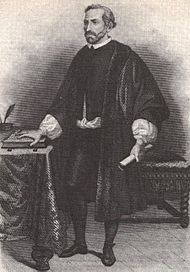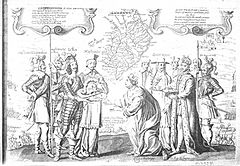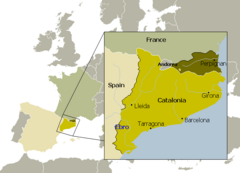Reapers' War facts for kids
Quick facts for kids Reapers' War |
|||||||||
|---|---|---|---|---|---|---|---|---|---|
| Part of the Franco-Spanish War (1635–1659) | |||||||||
 Battle of Montjuïc (1641) by Pandolfo Reschi |
|||||||||
|
|||||||||
| Belligerents | |||||||||
| Principality of Catalonia |
|||||||||
| Commanders and leaders | |||||||||
|
Francesc de Tamarit Josep Margarit |
|||||||||
The Reapers' War (also known as the Catalan Revolt) was a big conflict that happened in Catalonia between 1640 and 1659. It was a part of the larger Franco-Spanish War (1635–1659). This war had a lasting impact because it led to the Treaty of the Pyrenees in 1659. This treaty gave parts of northern Catalonia, like County of Roussillon and northern County of Cerdanya, to France. This changed the borders of Spain to be along the Pyrenees mountains.
Contents
Why the War Started: The Background
The war began because people in Catalonia were unhappy. The Spanish king's army, made up of soldiers from many different countries, was staying in Catalonia. This was during a big war between France and Spain, which was part of the even bigger Thirty Years' War.
Catalans also didn't like the Spanish government's plan to centralize power. This meant the government wanted to control everything from one place.
King Philip IV's Policies and Catalan Resistance
Gaspar de Guzmán, Count-Duke of Olivares, who was a top advisor to King Philip IV, wanted to share the costs of the Spanish Empire more fairly. He created a plan called the Union of Arms. This plan asked all parts of Spain to contribute soldiers and money.
However, this plan caused a lot of anger and protests, especially in Catalonia. The Catalan leaders, in meetings called the Catalan Courts, strongly opposed these new rules. They felt these rules broke their traditional laws, known as the Catalan constitutions.
Leaders of the Revolt
In 1638, a priest named Pau Claris became the president of the Generalitat. This was Catalonia's main governing body. He was known for standing up against the king's wishes.
Other important leaders included Francesc de Tamarit and Josep-Miquel Quintana Torroella. Around this time, ordinary people, especially farmers, started to feel the same way as their political leaders. They felt that the government was treating them unfairly.

The Bloody Corpus Uprising
The anger grew, leading to a major uprising in Barcelona on May 1640. This event is known as the 'Bloody Corpus' (Corpus de Sang). People shouted slogans like "Long live the faith of Christ!" and "Death to bad government!"
The uprising started after a farmer (called a segador or reaper) was killed. The rebels, who were often farmers, then killed the Spanish Viceroy of Catalonia, who was the king's representative. This event marked the official start of the Reapers' War. The local fighters were called "Miquelets".
The Spanish government was surprised because most of its army was fighting in other places. They quickly realized they needed more soldiers in Barcelona to stop the revolt.
The Conflict Unfolds
Pau Claris, the President of the Generalitat, gathered political leaders from all over Catalonia. They formed a special assembly called the Junta de Braços or Braços Generals. This group started making big changes.
- They created a Council of Defense to protect Catalonia.
- They introduced a special tax for the rich nobles.
At the same time, the Generalitat secretly talked with France to form an alliance.
Catalonia Joins France
By an agreement called the Pact of Ceret, France promised to help Catalonia. On January 17, 1641, the assembly led by Pau Claris declared Catalonia a Catalan Republic. This republic was under the protection of the French king.
However, this republic only lasted a week! On January 21, 1641, the Catalan leaders declared the French king, Louis XIII, as the new count of Barcelona. This meant Catalonia was now under French rule.
Battles and Shifting Loyalties
Spain's Habsburg monarchy was very worried about France gaining power south of the Pyrenees. So, they sent a large army of 26,000 soldiers to stop the Catalan Revolt.
On their way to Barcelona, the Spanish army took back several cities. They defeated a rebel army near Barcelona on January 23. But just three days later, the combined French and Catalan armies won a big victory against the Spanish at the Battle of Montjuïc on January 26, 1641.
Despite this success, the peasant uprising became harder to control. Sometimes, the farmers even fought against the Catalan nobles and the Generalitat itself. This showed that the conflict was also a "class war," with poor farmers fighting against both the Spanish king and their own wealthy leaders. This is why the Catalan leaders turned to France for help.
For the next ten years, Catalans fought alongside France. But over time, France started to control more and more of Catalonia's affairs, like ports and taxes. This made many Catalans less enthusiastic about being allied with France.
Key Battles and Sieges
A combined French-Catalan army won some battles in the south. However, they failed to capture important cities like Tarragona (in 1644), Lleida, and Tortosa.
In the north of Catalonia, in a region called Roussillon, they had more success. The city of Perpignan was captured from the Spanish after a long siege of 10 months. Soon, all of Roussillon was under French control.
In 1652, the Spanish army launched a major attack and recaptured Barcelona. This brought the Catalan capital back under Spanish control. Even after this, some small groups of rebels continued to fight for several years.
A Distant Connection: The Arauco War
At the same time as the Reapers' War, Spain was also fighting another long and expensive war far away in Chile. This was the Arauco War, where the Spanish fought against the native Mapuche people.
Because Spain was so busy fighting in Catalonia, the king ordered his leaders in Chile to make peace with the Mapuche. This allowed Spain to focus all its soldiers and money on the war in Catalonia. This was a unique event, as the Mapuche were one of the few native groups in the Americas to get a peace treaty and recognition from the Spanish crown.
How the War Ended: Resolution
The Reapers' War continued even after the Peace of Westphalia treaty in 1648, which ended the larger Thirty Years' War. It remained part of the ongoing Franco-Spanish War (1635–1659).
In 1652, the French leaders gave up their claim to most of Catalonia. However, they kept control of Roussillon. This led to the signing of the Treaty of the Pyrenees in 1659. This treaty officially divided Catalonia, giving Roussillon to France.
The fact that Spanish troops were so busy fighting in Catalonia also helped Portugal. On the other side of Spain, Portugal was fighting for its independence from Spanish rule in the Portuguese Restoration War. Because Spain's army was tied up in Catalonia, Portugal was able to win its freedom.
See also
 In Spanish: Sublevación de Cataluña para niños
In Spanish: Sublevación de Cataluña para niños
- "Els Segadors" ("The Reapers"), this is the official national anthem of Catalonia. Its current words are from 1899, but they are based on this revolt.
- The Fronde, a French uprising between 1648 and 1653 that Spain supported.
- Revolt of the Barretines, another Catalan revolt that happened later, from 1687 to 1689.
- Slovak Uprising of 1848–49, a similar revolt in Slovakia from 1848 to 1849.
- Joan Pere Fontanella, a Catalan judge and lawyer from that time.




